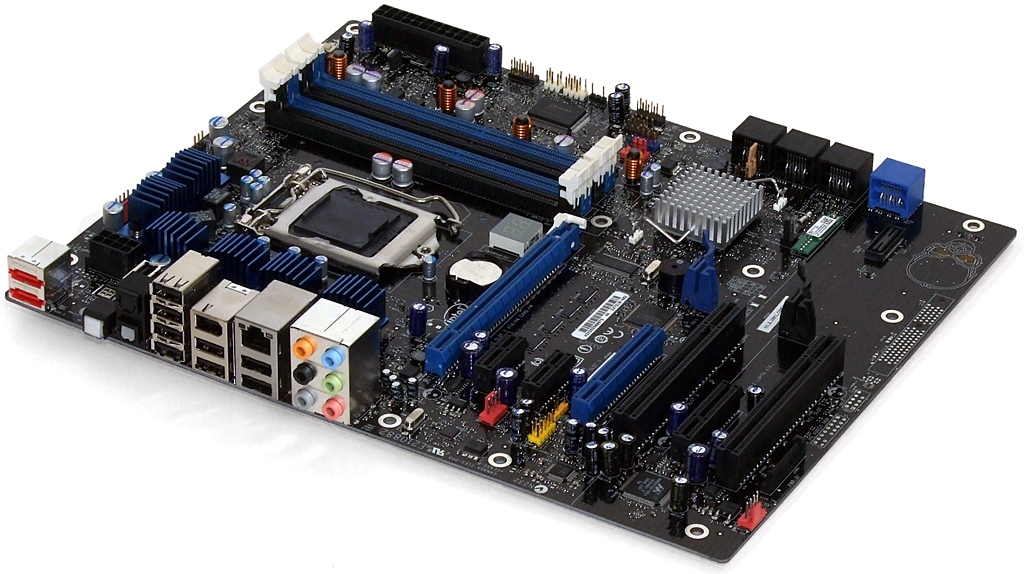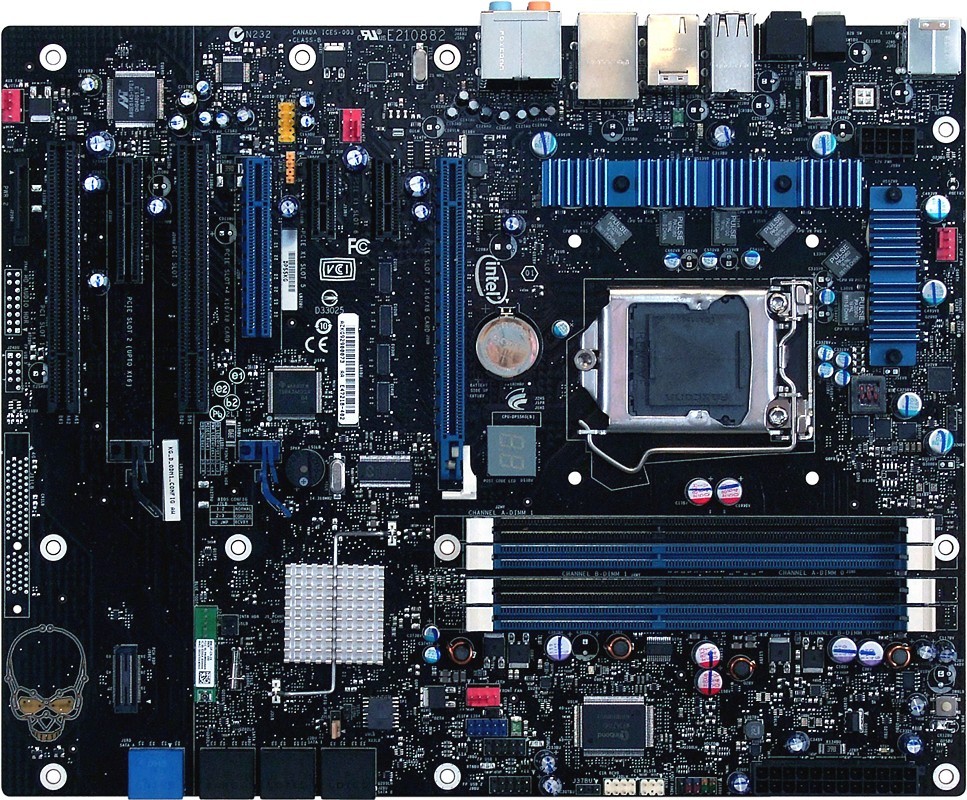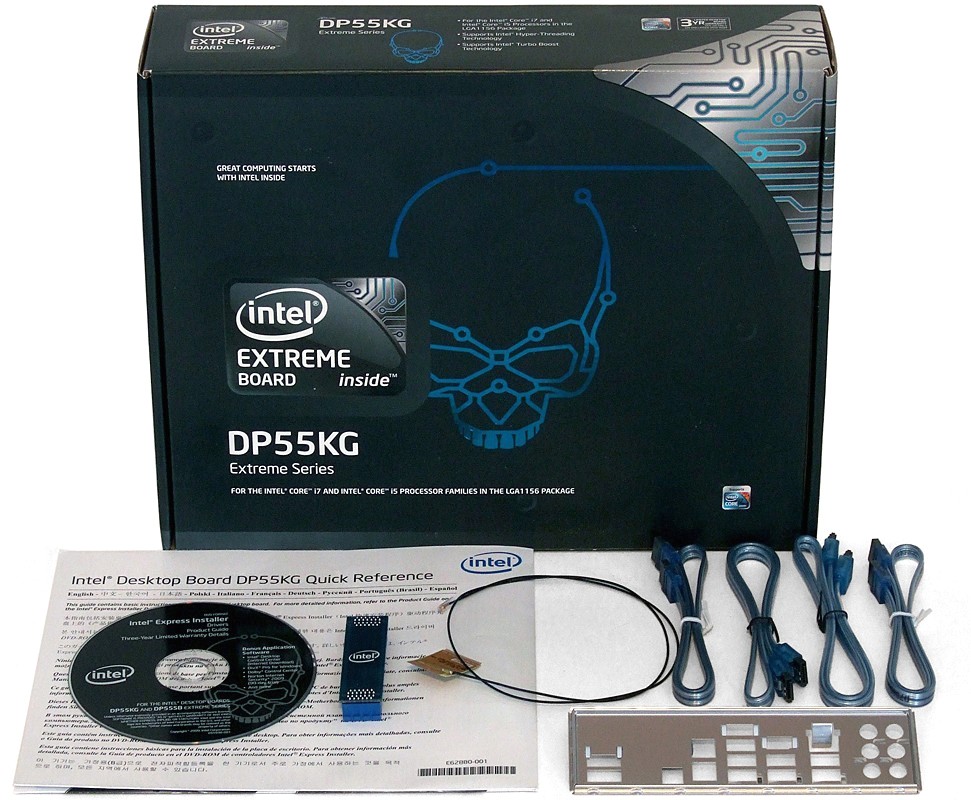P55 On Boost: Five LGA 1156 Boards Between $200 And $250
Intel DP55KG
Normally thought of by enthusiasts as an processor and chipset vendor, Intel also has its own brand of motherboards. These were traditionally produced to Intel’s higher-quality standards by third-party manufacturers to satisfy the needs of whitebox and large scale OEM builders, providing added stability in applications as constant-duty office PCs and workstations. Yet for several years Intel has also embraced the enthusiast market, while its DP55KG could be the best-suited product yet. Unlike the DX58SO that preceded it, the DP55KG has no weird graphics-slot order or peculiar number of DIMM slots.
The DP55KG is the only board in today’s roundup to exclude any PS/2 ports on the I/O panel. We don’t see any advantage to that exclusion since Intel didn’t make use of the remaining I/O panel space, but there are builders out there who truly hate legacy connectors. Other Intel I/O panel exclusives include an external digital audio input connector and a "Back to BIOS" button that forces the board to boot at default values without deleting custom presets, which makes a recovery from a failed overclocking attempt easier.
Also missing from the I/O panel compared to typical motherboards of the $200+ enthusiast class is any secondary wired-network connection, but Intel thinks it has gone one better by instead supplying the DP55KG with integrated Bluetooth personal area networking (PAN). With the ability to wirelessly transfer data to and from mobile devices and Bluetooth-enabled printers, Intel’s decision might be a good bet.
It’s no coincidence that the DP55KG looks exactly like an extended version of the company’s DP55SB microATX motherboard, as the smaller board was designed to provide similar capabilities for portable gaming machines. The big board adds an open-ended PCIe x4 slot with a separate card latch where it would normally be found on an x16 slot, an extra PCI slot, an extra fan connector, and two more SATA 3.0 Gb/s ports via Marvell’s PCIe-based 88SE6121 controller.
We wouldn’t want to exclude any mention of the skull logo, which can be set to a broad number of lighted modes, but the most interesting feature of the DP55KG (as well as its smaller sibling) is its CrossFire and SLI capability. The uppermost PCIe x16 slot is located in the top-slot position for extra cooling space between it and the x8 slot beneath, a part that’s also open-ended to support x16 cards and has a card latch where it would normally be found on the longer interface. The combination is functionally identical to the Asus P7P55D Deluxe we praised earlier, with four double-pathway electronic switches automatically configuring x16/x1 or x8/x8 modes depending on what type of card is installed in the x8 slot.
Intel relies on a six-phase digital CPU voltage regulator rather than the elaborate 19-phase Asus analog part and its memory slots are latched on both sides rather than one. Installing and removing memory with a graphics card already in place is more difficult, but the latches give clamp-on memory-cooling fans a gripping point.
Intel added a new location for its front-panel audio connector at the bottom of the DP55KG, but thankfully left this connector in the original DP55SB position. We say thankfully because the front-panel audio jacks of modern cases are typically located near the top-front corner, and connecting closer to the board’s center point eases cable installation.
Get Tom's Hardware's best news and in-depth reviews, straight to your inbox.
One extremely unique feature of the DP55KG (and its microATX clone) is the upward-facing USB 2.0 connector on the board’s top side, which is in front of the I/O panel’s “Back to BIOS” button. We’re not certain what Intel’s intentions are, although it does make the microATX version a perfect match for the USB remotes of some cases. We also think it might be a good place to install a USB thumb drive repurposed for Windows ReadyBoost.
BIOS
Although it looks like traditional BIOS, Intel’s DP55KG uses an extensible firmware interface as described in an upcoming UEFI article. This is, in fact, the same motherboard model used in that article, with the same artificial 2TB boot partition limitation in Intel’s RAID manager that would normally apply to non-EFI systems. Because this is an artificial limitation of the RAID system, disabling chipset RAID enables boot partitions larger than 2TB as seen on that upcoming story's solution page.
The main Performance menu is used to change the CPU base-clock settings, with several submenus for advanced configuration.
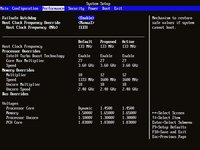
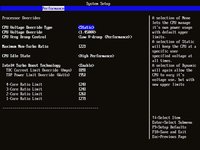
The Processor Overrides submenu includes CPU-voltage and voltage-droop compensation settings. While we were unfamiliar with the screen, we had no trouble achieving the required settings for our overclocking stability tests.
The Memory Configuration submenu retains automatically detected timings as the base value when switching from automatic- to manual-configuration modes.


A Bus Overrides submenu allows altering P55 PCH voltage and PCIe frequency.
Accessories
As a legacy-free product, the DP55KG’s accessory kit isn’t littered with support for outdated devices, although we would have liked to see at least six SATA cables included with a board that supports eight internal drives. Intel saves some trees by including the full installation manual only in digital form, but does add the necessary Bluetooth antenna and SLI bridge.
-
liquidsnake718 Always the question in mind. Is it possible for the manufacturers to make a P55 with FULL SLI 16x 16x? I wouldn’t know. I do know tests have proven that the difference in a 8x, 8x isnt all that bad but If I were going to invest next year on a motherboard Id want the best possible one for the best possible "upgradability".Reply
Also for just $50 more one could get a reasonable X58 board and the core i7 920 would be a great buy. The only motherboard here that would be a "smart" buy with "long term" in mind would be the Gigabyte UD6 since it at least sports USB3.0 AND Sata 6.0. One would not need to purchase any expansion card for this feature as it will be used in the years to come. Also knowing that X58 will be used for 6core chips way ahead is comforting as these boards then will still be around and mainstream by the time those processors will even be relevant for avid/regular PC users.
I just have a few questions you may be able to answer, do you guys also choose motherboards from other countries? I have seen Foxconn and Emaxx in some reviews but I also know that they may not be the best quality boards but it would be great to compare those boards as well. Its also good that you placed a reference Intel P55 so people would know the standard in which to compare with. Also how come we still dont have a P55 or X58 XFX board? Has XFX stopped making mb's and only started to focus on GPU's?
-
nerrawg liquidsnake718"Is it possible for the manufacturers to make a P55 with FULL SLI 16x 16x? I wouldn’t know."Reply
In the article first page:" Can any LGA 1156 system truly be considered high-end? After all, there’s no practical way to supply two graphics cards with a full 16 lanes of bandwidth. However, only the most expensive graphics cards need more than eight PCIe 2.0 lanes, and not every high-end buyer wants a gaming system."
The reason for this is the GPU - CPU bridge on core i5 systems, which in previously intel boards was part of the southbridge chipset, is now integrated onto the CPU. Therefore it isn't the boards that limit GPU lanes to a maximum of x16 lanes total, but it is the p55 core i5 & i7 CPUs that do this.
Check this link for more on the CPU-motherboard layout:
http://www.tweaktown.com/articles/2920/intel_s_p55_express_lynnfield_chipset_overview/index2.html -
I not quite agree with Gigabytes UD6 being the best choice with "long term" in mind. If using USB3.0 or SATA3, your VGA will run at 8x PCIe 2.0 instead of 16x. That might not be a problem with mainstreamcards, but would you rather have your high end GTX295, R5870 or R5970 run at 8x or 16x? I know what I want when buying a topdog card.Reply
Also see this artice on VR-Zone which explains the pitfalls of Gigabytes USB3/SATA3 implementation: http://vr-zone.com/articles/gigabyte-p55a-boards-usb3-sata3-issues-analysis/8158.html -
tacoslave the 8x pci was the only thing that kept me from buying an i5 but instead i got a phenom II 955 and never looked back and i got a great deal with a bundle from newegg. gotta love em.Reply -
kumaiti I would like to suggest a little more depth on the software features of each board. Performance tests are nice and everything but the differences are so small that often the features are the main deciding factor on getting a Mobo. It would be nice to know, for example, which boards support Dolby Digital Live.Reply -
Crashman kumaitiI would like to suggest a little more depth on the software features of each board. Performance tests are nice and everything but the differences are so small that often the features are the main deciding factor on getting a Mobo. It would be nice to know, for example, which boards support Dolby Digital Live.Reply
Good point, perhaps the features comparison chart could be expanded a little. -
apache_lives 1156 platform is mid-range, if you want the full 16x + 16x you go for 1366 its that simple, and nativly there are not enough lanes for dual 16x slots btw and nvidia chips can open them up to almost 16 16 but no real benifit anyhowReply
who would buy a Phenom II rig to get 16 16? not comparing AMD but you would see better performance from a high model i5 with 8 8 lol good one -
donkeykong2009 It will be great to see the performance impact on the Games for the Gigabyte board when USB 3.0 and SATA 3 is enabled.Reply -
Crashman donkeykong2009It will be great to see the performance impact on the Games for the Gigabyte board when USB 3.0 and SATA 3 is enabled.Reply
You can't enable USB 3.0 and SATA 6.0 Gb/s at the same time. -
I'm not talking about full speed CrossFireX or SLI at two times 16x PCIe speed. I'm talking about single VGA solutions. I want my HD5970 to run at fullspeed 16x PCIe express and that's not happening if I connect a USB3 or SATA3 device. Even in single VGA setups, the speed will be cut in half on my PCIe 16x slot to 8x.Reply
I'd rather have the ASUS or MSI (GD85) solution who use an additional PLX chip. The question was about being future proof and the Gigabyte solution is not as future proof as it seems.
Unfortunately Intel seems to be steering away from the X58 platform. There are more and more P55 motherboards coming out which have high end features. The top end Lynnfield CPUs have no problem outrunning the lower end Bloomfield CPUs. So saying a 1156 is midrange... that's giving it less credit than it deserves.
Btw, there are P55 mainboards from ASUS, MSI and EVGA with an NF200 chipset which do offer fullspeed dual CrossFire/SLI at 16/16. And those definitely don't have midrange prices. :o
